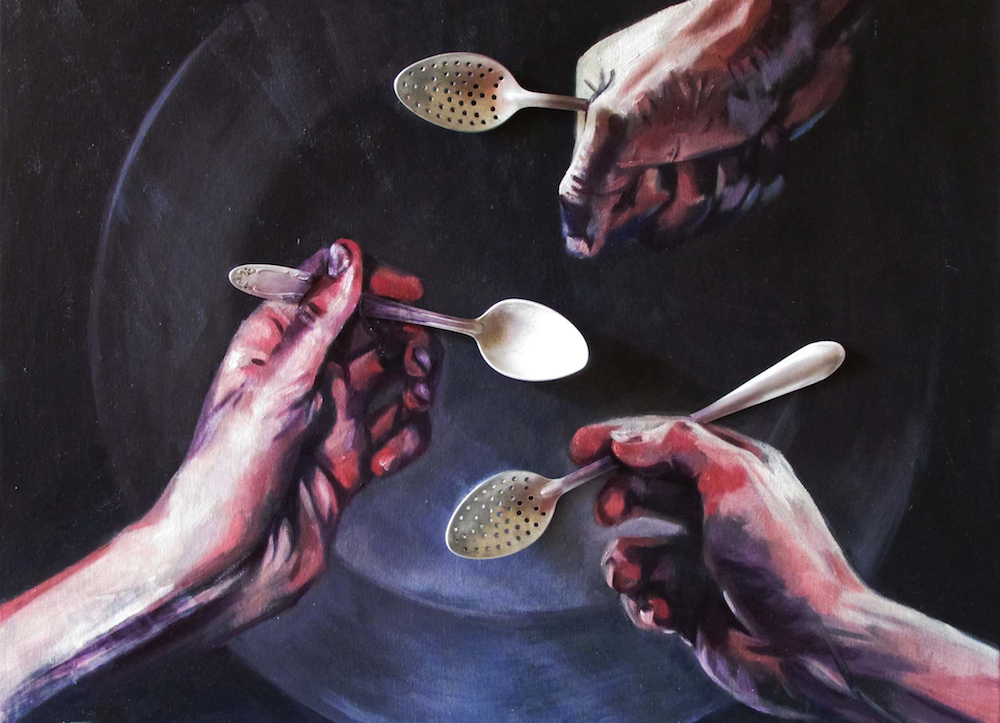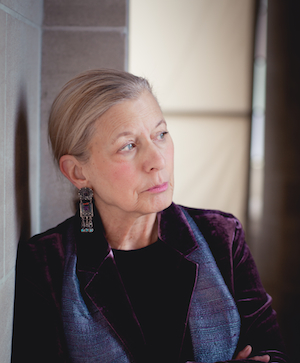Essay by Rebecca Taksel
Learning to Love What Really Matters

In 1961, I was eighteen, one of that swarm of college girls memorialized by Bob Dylan in “Like a Rolling Stone.” Having grown up in provincial Pittsburgh, my only claim to hipness was a love for jazz that had included visits to New York clubs with my family all through high school.
The Cedar Tavern and the White Horse in the East Village were not jazz clubs. They were loud, smoky bars where, among other questionable types, avant-garde artists hung out. My sophisticated Sarah Lawrence friends took me there. I knew nothing about abstract expressionism, action painting, or the New York School. But I wanted to be with those artists, to be hip.
On my second or third visit to the White Horse (or maybe the Cedar), I was introduced by an artist acquaintance to Willem de Kooning, who stood in a circle of admirers. He was already famous, a truly beautiful man in his late fifties with chiseled features, pure white hair, and long delicate hands.
He looked at me, said nothing, then placed one of those beautiful hands over one of my breasts.
I don’t know how long he left it there. I was immobilized, as if his hand carried a paralyzing electric shock. I couldn’t hear if the other men present said anything or whether they laughed; I was deaf to everything except the pulsing roar in my head.
Finally, I recovered my wits a little. With affected carelessness, I handed my bottle of beer to de Kooning while fetching a cigarette from my purse. Was I so desperate to appear cool? In a word, yes.
A taboo of eighteen years’ standing had been shattered in an instant, and I was complicit. There I was, hanging out in a disreputable bar, so I must have deserved what happened to me. I was ashamed—I know that now—but I had been so thoroughly conditioned that my shame, along with a jumble of other feelings, got short-circuited. My numbness covered a subconscious awareness of how my body, my person, had been violated.
It would take years for that awareness to break the surface, but when it did, it went far beyond a purely intellectual understanding of male sexual aggression. Our bodies are learning organisms. Physical experiences are often the strongest, most direct ways we interpret the world, even if we don’t know what we’re feeling at the time.
I wish I could report that the de Kooning incident was enough to keep me out of dives like the White Horse. It did not. I continued to look for art in all the wrong places. I was sure I was in the presence of genius. Like legions of women before and after me, I fell prey to the spectacularly wrongheaded idea that an imperfect, even humiliating affair with a brilliant, talented, or famous man was better than a relationship with a man who was merely good and kind and loved you back.
I did leave New York at the end of the year. I studied foreign language in Geneva and French literature back in the States. I visited museums and galleries. I turned my attention to the art of earlier times, gratefully, lovingly. I didn’t talk about art, because I felt entirely unqualified to do so; I just looked at it. I became a French teacher but surprised myself by loving the many American artists who’d studied and worked in France: Whistler, Sargent, Cassatt, Homer.
Meanwhile, the New York art scene continued to advertise itself as having eclipsed Paris. Its movers and shakers (and fakers) said New York had revolutionized art forever, abolishing the representation of mere objects and figures. It moved restlessly from ism to ism, from pop to op to minimal, from post-this to post-that, from happenings to installations.
One thing did change. By the 1970s, female curators began dusting off women’s work of past centuries and hanging it alongside that of their male counterparts. The work of Berthe Morisot bookended the bold experiments of her friend Edouard Manet, for instance, just as the friendship of Edgar Degas and Mary Cassatt influenced paintings by both.
I happened to be at a party in Chicago when I met an artist who named herself after her hometown: Judy Chicago. Working in California in the early ‘70s, Chicago was outrageous, theatrical, her West Coast swagger a match for the New York crowd. And women who had been in the shadows of that crowd were now emerging, among them Lee Krasner, wife of one of the biggest New York boys, Jackson Pollock, and Elaine de Kooning—yes, de Kooning—wife of Willem. Maybe the women weren’t “of the first rank,” as the expression went at the time, but they were becoming visible.
So were my feelings. I didn’t revisit the embarrassment and shame of my meeting with de Kooning until the mid-‘70s. As a committed feminist, I had an intellectual understanding that the personal is political, although it was still hard to bring such a repugnant personal and physical memory into the public realm. Even saying the word “breast” out loud in front of women in a consciousness-raising group felt overwhelming—but I did it.
I don’t believe good art is made only by good people; I wish it were so. But I finally realized that I had a right to resist art that repelled me. Because abstract expressionism had repelled me, just as surely as had de Kooning’s hand on my breast. It was mostly about male power. Those huge canvases! That slapping and flinging and smearing of paint! That gleeful trampling over centuries of beauty!
Willem de Kooning died in 1997, but his work is still displayed in major museums around the world. (In 2015, David Geffen sold de Kooning’s “Interchange” to hedge-fund billionaire Ken Griffin for $300 million. It was the highest price paid for any painting up until that time.) De Kooning was a particularly pure representation of the Great Man of Art. He’s always arrogant, the Great Man, and often cruel. He has a wife or a mistress or a model (or all three) who serves art by serving him. At night, he dons his cape and slouch hat—or in more recent times, his turtleneck and black jeans—to go off to drink, pontificate, and collect specimens of youth and beauty. He’s still out there, still intimidating critics and collectors and, worst of all, young girls and boys in search of an artistic ideal to worship.
But de Kooning the Great Man did me a favor, too. When he indulged in a public gesture that the dirtiest of dirty old men I knew back home wouldn’t have dared, he opened a tiny crack in the wall of cultural norms that had demanded my acceptance of sexist artistic fashions. And when the seismic shifts of the ‘60s and ‘70s began, I had my own personal moment of shock to add to the general eruption. Great Man, indeed! After you confront the arrogance and the shaming, then comes the laughter. It can take a long time. But as feminism settled into my brain and bones, I was able to laugh at quite a few Great Men and eventually to become immune to them.
Just as important, I became somebody who trusts her own ideas about art. I’m not a professional art critic, but I sometimes call myself one to assert my right to look. Really, though, I’m an amateur, someone who loves what they’re looking at. Whenever I’ve written about art, it’s as an amateur, embracing the French derivation of that word, and I prefer it, because money and Art World influence don’t matter to me.
Since the 1970s, I’ve never felt intimidated about reacting to art and talking about my reactions. I’ve deplored much of the I’m-an-artist-so whatever-I-do-is-art on display everywhere from international shows to Chelsea galleries to provincial Pittsburgh. I’ve even modified my earlier loathing of abstract expressionism. The movement brought respect and museum interest to the work of one towering genius: Mark Rothko. Without New York and the New York School, he probably wouldn’t have been recognized.
But I’ve spent much more time discovering and rediscovering the art I love: the delicate lines of Egon Schiele; the fantastical watercolors of Charles Burchfield; the universe of art called “naïve” or “outsider,” a field in which women are richly represented. One of these outsiders, Séraphine de Senlis Louis, is the subject of a wonderful 2008 French film based on her life called Séraphine. I’m proud to say I’ve encouraged generations of students to look at French and American art—to become amateurs like me.
Publishing Information
- “Billionaire Paid $500 Million for Abstract Expressionist Paintings in Record Art Deal,” Telegraph (Bloomberg), February 23, 2016.
Art Information
- "Hunger—Oil—Iron" © Kateryna Bortsova; used by permission.
 Rebecca Taksel is a retired professor of French language and literature. From 2003 to 2014, she was a contributor and then contributing editor of the Redwood Coast Review, where her cultural criticism and memoir pieces appeared regularly. She’s also published prose and poetry in various print and online magazines. Her writing on interior design appeared in the early 2000s in Natural Home, and she’s written about animal rights for Animals Agenda.
Rebecca Taksel is a retired professor of French language and literature. From 2003 to 2014, she was a contributor and then contributing editor of the Redwood Coast Review, where her cultural criticism and memoir pieces appeared regularly. She’s also published prose and poetry in various print and online magazines. Her writing on interior design appeared in the early 2000s in Natural Home, and she’s written about animal rights for Animals Agenda.
For more information, see Rebecca Taksel’s website.
